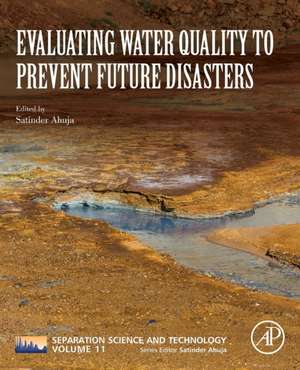Evaluating Water Quality to Prevent Future Disasters: Separation Science and Technology, cartea 11
Satinder Ahujaen Limba Engleză Paperback – 24 mai 2019
- Highlights reasons for potential water catastrophes
- Provides separation methods for monitoring water contamination
- Encourages development of new methods for monitoring water contamination
Preț: 801.82 lei
Preț vechi: 1032.03 lei
-22% Nou
Puncte Express: 1203
Preț estimativ în valută:
153.42€ • 160.19$ • 126.98£
153.42€ • 160.19$ • 126.98£
Carte tipărită la comandă
Livrare economică 29 martie-12 aprilie
Preluare comenzi: 021 569.72.76
Specificații
ISBN-13: 9780128157305
ISBN-10: 0128157305
Pagini: 456
Dimensiuni: 191 x 235 x 29 mm
Greutate: 0.78 kg
Editura: ELSEVIER SCIENCE
Seria Separation Science and Technology
ISBN-10: 0128157305
Pagini: 456
Dimensiuni: 191 x 235 x 29 mm
Greutate: 0.78 kg
Editura: ELSEVIER SCIENCE
Seria Separation Science and Technology
Public țintă
Separation scientists, environmental scientists, chemists, academics, industry professionals, NGO employees, and governmental employees.Cuprins
1. Overview: Evaluating Water Quality to Prevent Future Disasters
2. The Heat Is On: Complexities of Aquatic Endocrine Disruption in a Changing Global Climate
3. Impact of Persistent Droughts on the Quality of the Middle East Water Resources
4. Present and Potential Water Quality Challenges in India
5. Arsenic Contamination in South Asian Regions: the Difficulties, Challenges and Vision for the Future
6. Cyanobacteria and Their Toxins
7. Educational Partnerships Combined with Research on Emerging Pollutants for Long-Term Water-Quality Monitoring
8. Evaluation of the Toxicity of the Deepwater Horizon Oil and Associated Dispersant on Early Life Stages of the Eastern Oyster
9. Analytical Methods for the Comprehensive Characterization of Produced Water
10. Innovations in Monitoring with Water-Quality Sensors with Case Studies on Floods, Hurricanes, and Harmful Algal Blooms
11. Biosensors for Monitoring Water Pollutants: a Case Study with Arsenic in Groundwater
12. Investigating the Missing Link: Effects of Noncompliance and Aging Private Infrastructure on Water-Quality Monitoring
13. GenX Contamination of the Cape Fear River, North Carolina: Analytical Environmental Chemistry Uncovers Multiple System Failures
14. Analysis of GenX and Other Per- and Polyfluoroalkyl Substances in Environmental Water Samples
15. Sustainable Magnetically Retrievable Nanoadsorbents for Selective Removal of Heavy Metal Ions from Different Charged Wastewaters
16. Lessons Learned from Water Disasters of the World
2. The Heat Is On: Complexities of Aquatic Endocrine Disruption in a Changing Global Climate
3. Impact of Persistent Droughts on the Quality of the Middle East Water Resources
4. Present and Potential Water Quality Challenges in India
5. Arsenic Contamination in South Asian Regions: the Difficulties, Challenges and Vision for the Future
6. Cyanobacteria and Their Toxins
7. Educational Partnerships Combined with Research on Emerging Pollutants for Long-Term Water-Quality Monitoring
8. Evaluation of the Toxicity of the Deepwater Horizon Oil and Associated Dispersant on Early Life Stages of the Eastern Oyster
9. Analytical Methods for the Comprehensive Characterization of Produced Water
10. Innovations in Monitoring with Water-Quality Sensors with Case Studies on Floods, Hurricanes, and Harmful Algal Blooms
11. Biosensors for Monitoring Water Pollutants: a Case Study with Arsenic in Groundwater
12. Investigating the Missing Link: Effects of Noncompliance and Aging Private Infrastructure on Water-Quality Monitoring
13. GenX Contamination of the Cape Fear River, North Carolina: Analytical Environmental Chemistry Uncovers Multiple System Failures
14. Analysis of GenX and Other Per- and Polyfluoroalkyl Substances in Environmental Water Samples
15. Sustainable Magnetically Retrievable Nanoadsorbents for Selective Removal of Heavy Metal Ions from Different Charged Wastewaters
16. Lessons Learned from Water Disasters of the World








